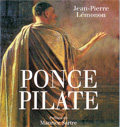Biography or Exegesis? The work dedicated to Pontius Pilate by Jean-Pierre Lémonon resembles more a meticulous archaeological dig, where the teaspoon and toothbrush replace the cruder excavation instruments. Yet who does not know, beyond the Christian world, this Roman Governor, administrator of the territory of Judea in the name of the Emperor, whose certain verdict would almost unwittingly participate in a shift in history? This is precisely the interest in the work of this Emeritus Professor and specialist of the 1st century, in replacing this “founding moment” of Christianity within the ordinary vicissitudes of imperial space and time, thereby allowing a more sober illumination of the famous decision of the “Paschal privilege.”
The book begins with an enigma: that of a mysterious and incomplete inscription mentioning Pilate’s name on a stone discovered during the excavations of Caesar’s theater. The author quickly transforms this piece of limestone into keys accessing the history of this province populated by Jews which knew “at the death of Herod the Great, in 4 BC, a period of agitation.” He sets the scene on the territorial organization of the Empire and describes the complex powers of the Governor of Judea, caught between the superior power of his colleague in charge of the province of Syria and the extreme power of the Caesar whom he represents. It is fair to say that his task is not easy. Always meticulous about sources, to the point of making the reading sometimes challenging, Jean-Pierre Lémonon examines the various affairs managed by Pontius Pilate.
The custody of the High Priest’s vestments, of which “each of the eight pieces expiated very specific sins,” was a recurring contention between the religious notables and the Governor, who was supposed to adapt to the variations of Jewish policy from Rome. An equally constant concern was the issue of money, both an indisputable symbol of sovereignty for the representative of the Empire but also had to consider the Jewish prohibition of any personal representation on the coins. This prohibition was more or less respected depending on political and diplomatic considerations regarding the Jewish community and also the temperament of the Governor. Perhaps this is where the exegete gives way to the historian: for Jean-Pierre Lémonon, Pilate was and remains a “clumsy” administrator. His decision to introduce into Jerusalem, “by night and veiled,” “effigies of Caesar” provoked a riot of Jews so determined that they managed to make him revoke this measure. He then constructed, financed by the sacred treasury of the Temple, an aqueduct, inciting violent opposition which he suppressed with bloodshed by his soldiers.
These two events highlight, according to the author, a personality little aware of Jewish sensitivity. Without this necessarily corresponding to an explicit instruction from Emperor Tiberius whose policy, compared with other Caesars, was rather conciliatory towards the Jews. The author also raises the idea of complicity with the priestly circles at the time of Christ’s Passion, without which, according to him, the trial could not have taken place. A trial of which he provides fascinating insights: from the historical conditions of the implementation of the “Paschal privilege” to the “influences” of the environment on Pilate’s decision, the professor also comments with numerous textual references on events other than the Passion itself (labeling of the cross’s inscription, the descent of Jesus’ body…).
It was the “massacre of the Samaritans” that spelled the end of Pontius Pilate’s power: under pressure from the inhabitants who addressed themselves directly to Rome, the Governor was recalled. As a sign of disavowal, his successor in Judea quickly appointed a new High Priest, replacing Caiaphas, the one who obtained the sentence against Jesus. Strangely, the precision of the exegete stumbles on the circumstances of the death of Pontius Pilate: suicide? death sentence? assassination? martyrdom of a man who became a Christian at the end of his life? All hypotheses are mentioned and referred to abundant bibliographies. It’s up to the reader to choose and “believe,” in a way, the correct version.
Jean-Pierre Lémonon, “Pontius Pilate,” Editions de l’Atelier, 2007, 304 pages, 23 euros.


